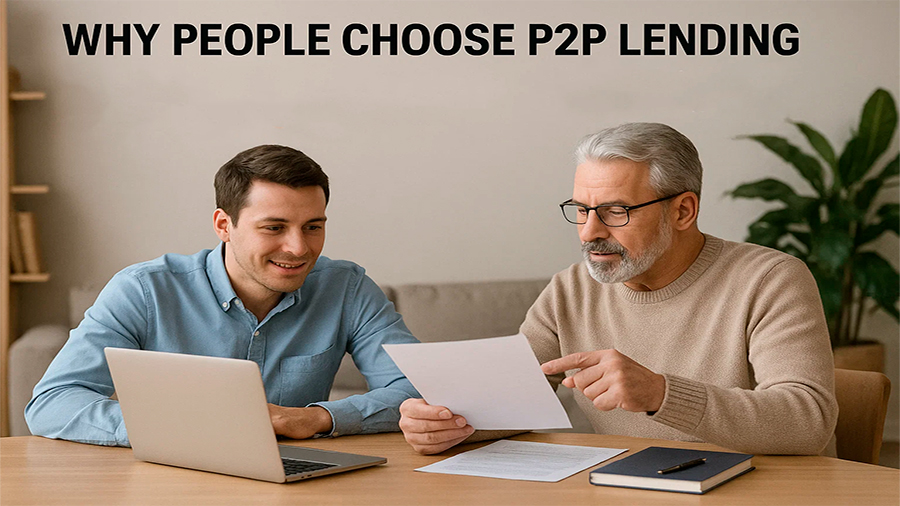For decades, if you needed a loan, you went to a bank. You filled out paperwork, waited for a decision, and hoped for approval. But now, something different is happening. Peer-to-peer (P2P) lending — where individuals lend money directly to other individuals online — is rewriting the rules of borrowing and lending. No branches. No middlemen. Just platforms where people meet digitally to handle credit themselves. It sounds simple, but it’s transforming how we think about who controls access to money — and who benefits from it.
How P2P Lending Works
Imagine you want to borrow $5,000. Instead of going to a traditional lender, you post your request on a P2P platform. Dozens — or even hundreds — of individuals can chip in to fund your loan. They earn interest on the money they lend. You get access to credit, often faster or at better terms than a bank might offer. And the platform takes a small cut for making the match and managing the payments.
The basics of the process
You fill out an application — often faster and simpler than at a bank. The platform assigns you a risk rating based on your credit history, income, and other data. That score determines your interest rate. Lenders browse listings and choose which borrowers to support. Once your loan is fully funded, the money hits your account. You repay over time — just like any loan — and the platform distributes your payments back to the lenders.
No banks — and fewer barriers
This model cuts out the institution. There’s no big financial firm acting as the middleman. It’s person-to-person, with algorithms handling the matchmaking and contracts. That’s why it’s called “peer-to-peer.” And for some borrowers, it’s a way around the rigid systems that have long excluded them.

Why People Choose P2P Lending
For borrowers, the appeal is clear: faster decisions, flexible terms, and sometimes better rates. For lenders, it’s a chance to earn more than a savings account might offer — with risk, of course.
Borrowers want speed and simplicity
P2P platforms often offer approval in hours, not days. The application process is more relaxed, with fewer documents and fewer hoops. For someone who needs cash to cover a medical bill, fix a car, or consolidate debt, that convenience matters a lot. In some cases, borrowers who’ve been rejected by banks — because of rigid credit rules — find help through P2P alternatives.
Lenders want returns — and purpose
People with money to invest are looking beyond traditional assets. Some want better returns. Others like the idea of helping real people, not just investing in faceless markets. P2P lending creates a direct connection. It feels more personal — even if it’s all online.
How It’s Changing the Credit Marketplace
P2P lending is more than a side option. In some countries, it’s becoming a significant part of the consumer credit market. And it’s not just small players anymore — major platforms are handling billions in transactions annually. That shift is forcing banks to rethink their own processes and pricing models.
New players in the credit game
Traditionally, only licensed institutions issued loans. Now, anyone with spare cash can act like a mini bank. That decentralization is shaking up the industry. It’s making lending more competitive, more digital, and more democratized. In some ways, P2P platforms are doing to loans what Uber did to taxis — removing the gatekeepers.
Changing borrower expectations
When people get used to fast approvals, personalized terms, and better user interfaces, they start expecting the same everywhere. Banks are now racing to streamline their systems and offer quicker decisions — a direct response to what P2P platforms have proven is possible.
Risks You Should Know About
Like any financial product, P2P lending isn’t risk-free — for borrowers or lenders. It’s not backed by the government. And there’s no bank to absorb the loss if something goes wrong. That adds freedom, but also danger.
Borrowers face legal consequences
Just because the lender is a person doesn’t mean the rules are soft. If you miss payments or default, the platform can send your case to collections or sue for repayment — just like any loan. The difference is that some platforms may be less forgiving than banks when it comes to hardship extensions.
Lenders can lose everything
Lending money always comes with risk. If a borrower defaults, there’s no guarantee of getting your money back. Most platforms offer risk ratings and data tools to help lenders diversify, but losses still happen. And since loans aren’t insured, a default hits your pocket directly.
The regulatory gray zone
P2P lending operates in a newer, evolving space. Regulations differ country by country — and sometimes, platform by platform. This lack of uniform protection can leave users vulnerable if a platform collapses or changes its terms. As the market grows, expect governments to step in with stricter rules.

What the Future Might Look Like
P2P lending is still maturing. Some early platforms failed or pivoted. Others merged with traditional financial institutions. But the core idea — that credit can be decentralized — is here to stay.
Hybrid models are emerging
Some platforms now mix individual and institutional funding. You might be borrowing from a group of people and a hedge fund at the same time — without knowing it. Others partner with banks for underwriting while maintaining the P2P experience. The line between old finance and new is blurring.
Integration with other fintech
P2P lending is also being integrated into broader financial ecosystems. Think buy-now-pay-later services, mobile banking apps, and even crypto platforms. As these services grow more connected, borrowing will feel more seamless — and possibly more tempting. That raises questions about responsible lending and consumer protection.
The Human Side of P2P Lending
One of the reasons P2P lending resonates is its emotional appeal. Lenders feel like they’re helping real people. Borrowers feel seen and understood in ways traditional banks don’t always offer. That human element is powerful — but it can also cloud judgment.
Empathy vs. due diligence
Lending based on emotion rather than risk data can backfire. While stories may be compelling, they don’t guarantee repayment. Platforms try to balance emotion and logic by offering tools, ratings, and borrower profiles. But the final decision is still yours — and so is the responsibility.
Conclusion
P2P lending is reshaping how people think about credit. It removes traditional barriers, speeds up the process, and gives both borrowers and lenders more control. But it also shifts the burden of risk onto individuals. No more hiding behind institutional walls. In the new credit marketplace, you’re not just a customer — you’re a participant. And with that comes freedom, opportunity, and responsibility.

